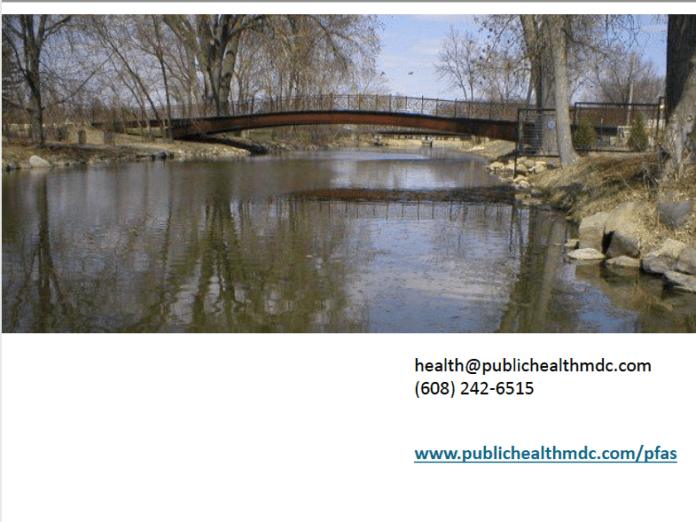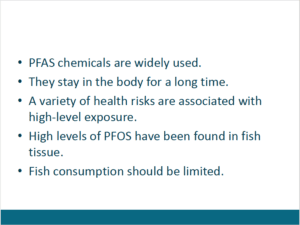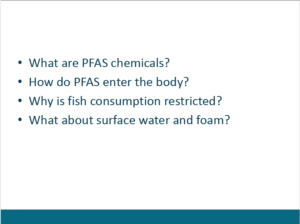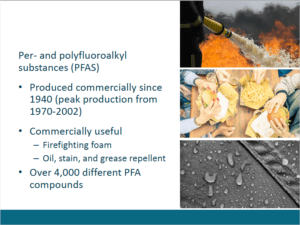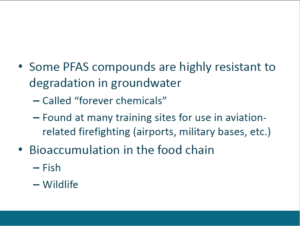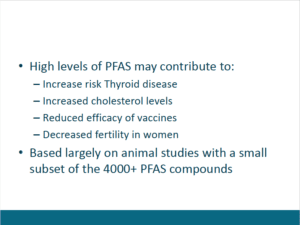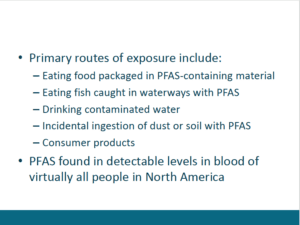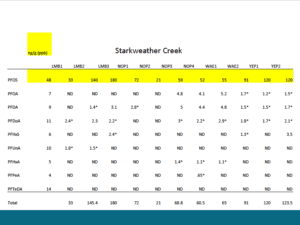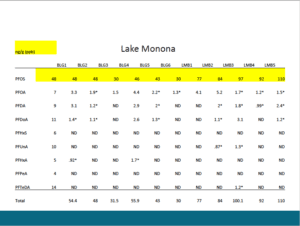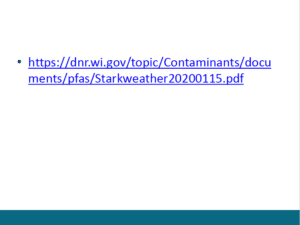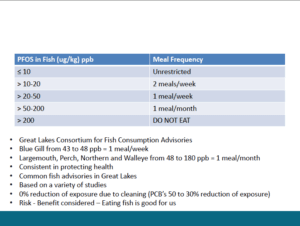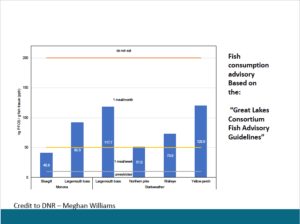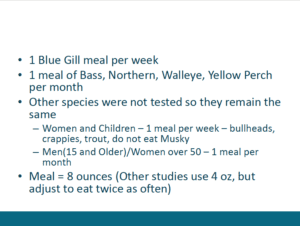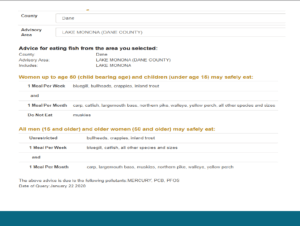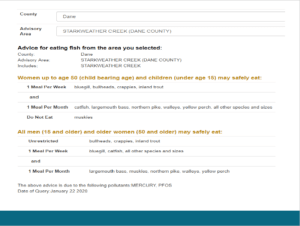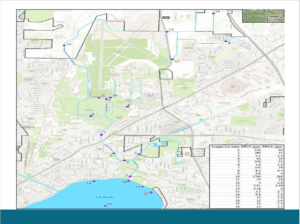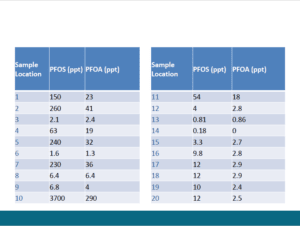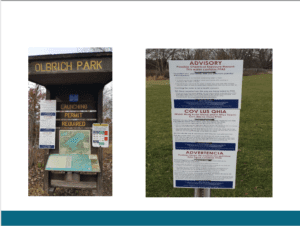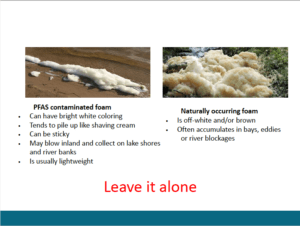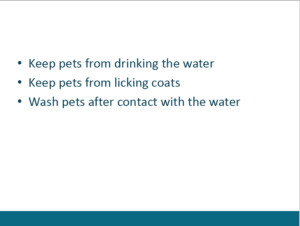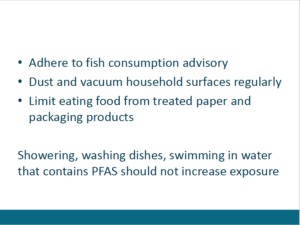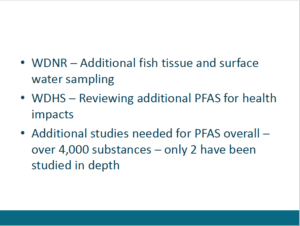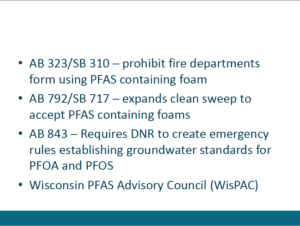Only 1 meal (8 oz) of bluegill a week and the rest of the fish only each once a month. Don’t touch the foam either. Other lakes haven’t yet been tested, but will be.
There is another meeting tonight – Wednesday, February 12 | 6:30—7:30 PM at East Madison Community Center 8 Straubel Court.
The first meeting was Saturday, February 8 | 10:30—11:30 AM. Here is the video. (my apologies for the hum!)
Here’s what the Health Department had to say and the Q&A from the audience throughout.
Doug Voegeli, Director of Environmental Health from the Public Health Department Madison and Dane County, Jeff Lafferty is also with him, he is the Environmental Epidemiologist. He introduces others in the room, Cristie Baumel from the Mayor’s Office, County Board Supervisor Paul Rusk and Michele Ritt, Alder Marsha Rummel and Grant Foster. Sarah Yang from DHS. Jim Amerine (sp?) from the DNR, Fish Consumption Specialist.
The scope of he meeting today is we’re going to talk about surface water results and we’re going to talk about fish tissue and the new fish advisory. I know that there’s probably a lot of questions and concerns about remediation and clean out and everything like that we’re not going to touch on those in this meeting, but I do want to let you know that there is a organization or group of us that are working together to provide a larger meeting that will entailed a lot more people. We’re thinking around mid-March we’re hoping for that and that would have all of our partner agencies DNR, DHS, Public Health Madison Dane County, the Air National Guard, city and county officials that would be a this meeting. Keep a lookout for that, that would go into more detail about the remediation plan. If you’re here for that, stay along, this is still gonna be a good presentation. I do also want to recognize Marisol is here for our Spanish interpretations and Pao is here for Hmong interpretation. Former Secretary Meyers (sp?) is also here.
So these are the important messages that we want to get out to everybody today. That we can carry with us today as we go talk to people in the community. The PFAS stands for a per- and poly- flluorinated alkylize substances, we’ll use that acronym a lot. I will also use PFOS, because that is the basis for our fish consumption advisories. The PFAS chemicals stay in the body for a long time it takes several years for them to to work their way out of our body once there. There’s a variety of health risks that are affiliated with PFAS substances, I will talk about. Especially in high levels and what we’re talking about and what we’re here for today is the high levels that have been found and our fish species in Starkweather and in Lake Manona. And then really the primary message is that we got to look at our fish consumption and ensure that we’re following the guidelines that have been set by the DNR.
We’ll try to answer some of these key questions, what are PFAS chemicals, how do they enter the body, why the consumption is being restricted, why it’s different here than elsewhere in the state and then we’ll touch briefly on surface water and foan.
Per and poly fluorinatedalkylized substances are substances that were started being produced in the 1940s. There are over 4,000 compounds and there can be more and more growing all the time, it just depends on the chemical structure. The peak production was from 1970 to 2002 and then they stopped using them both the two PFOA, PFOS was discontinued 2015. They’re commercially useful, they’re very good at the job that they do and that’s why they’ve been so much in a lot of our products that we see and use every day. They’re very good at putting out fires, they form a barrier and just starve that fire and the fire is out in a matter of seconds. They also have a lot of great oil, grease and stain resistant capabilities, which makes it very useful for cleaning or repelency for water is great fro products like gore-tex jackets or anything. And again there’s over 4,000 types of the compounds and there can be more as time goes on. Which is one of the one of the issues that we often hear about, we know something about 2 of these compounds, PFOA and PFOS, the other three housand nine hundred and ninety eight plus we don’t know too much about at all. Because they haven’t been studied like the two PFOA, PFOS. Hopefully they will be studied here in the future, especially with all the press and everybody starting to realize the PFAS problem and issues that we have with them right now.
So the compounds don’t break down in the environment, they are resistance breakdown, they enter our groundwater and our surface water and eventually they enter our fish. They’re commonly called the forever chemicals because they don’t break down, they don’t go anywhere. They’re there in our environment and we need to be removing them proactively to get rid of them and discontinue the use of them as well. They’re found in a lot of training sites, military sites, airports. They’re also found in some of the manufacturing, 3M in Minnesota, there’s a lot of PFAS from around there manufacturing as well as Wolverine, a boot manufacturer in Michigan where high levels of PFAS have been found because of the scotchgard and different materials they use on boots to keep them water repellent. Another important environmental concern is that the PFAS does bioaccumulate in fish and in wildlife and that’s one of the things that we will be talking about here in just a moment.
PFAS does have health impacts and we don’t want to be consuming PFAS. We want to ensure that if there are high levels of PFAS that we are avoiding the ingestion of the PFAS and avoiding health impacts. High levels can increase the risk of thyroid disease, increase your cholesterol levels, they can reduce the efficacy of vaccines and decrease the fertility in women. Again, this is based, all of these studies are based primarily on two different compounds, there’s not a lot of work compounds other than PFOA or PFOS. There is a lot of unknown out there in regard to these chemicals.
So this is something that I just hope that we can all leave thinking about, when we look at risks and we look at contamination, we look at primarily three routes of exposure, ingestion, or eating it, inhalation or breathing it or dermal, going through our skin. The primary route with PFAS is ingestion. So we just think about ingestion as being where most of our PFAS are coming from. From either like the packaging of the food that we are eating, there could be PFAS in there as we eat the food, and then we are taking some PFAS in as we eat the food. What we’re talking about here today is the fish and the amount of PFAS that are in the fish and that the fish are eating and we are ingesting that as well. Ingestion of dust or soil, soil around areas of high industry and manufacturing would have high levels of PFAS and some how if we are getting that soil into us, again we are ingesting it or the dust that’s around that soil. Also dust in your home, that could be a breakdown product, if you had Scotchgarded materials to your home or on your couches or carpeting, that breaks down and beomes dust and then you are ingesting it. Unfortunately we have PFAS most likely, I would say everyone in this room has PFAS in their blood, because of the wide use of it throughout the globe and throughout the world, that we have all ingested some and we will have a certain level in us.
Today we want to specifically focus in and talk about the special fish consumption advisory that has been put out by the Department of Natural Resources for Lake Manona and Starkweather Creek. I kind of wanted to step through the tissue results here so you have some idea how it was done. On the left-hand side are the different PFAS substances that were tested for, and across the top are the species that were tested. So if you can see this is Starkweather Creek, you have largemouth bass, northern pike, walleye and yellow perch. The other thing I want you to notice is that this is parts per billion, when we’re talking about PFAS in water we talk about it in parts per trillion, so the results that you see here if you want to make them the same as what we see, for instance with the Department of Natural Resources, the Department of Health have put out a recommendation of 20 parts per trillion in ground water, so keep at a in mind too. Ground waters is different than surface water, it’s different than fish. But just use that as kind of a guide when you see some of these numbers.
PFOS is the one that the one PFAS that accumulates in fish the best. Other ones reduce pretty quickly, so this is kind of the one that’s used for the fish consumption advisory used by the Great Lakes which we will talk about in a little bit, so that’s the one that we should concentrate on, those numbers up on the top there. Parts per billion if you want to make it into parts per trillion add three zeros at the end of each one of those numbers to give you some idea. So we are talking some fairly significantly high levels in fish. These are the rest of the compounds that were found. ND means non-detect, to there was no PFAS detected in some of them. And then at the bottom is the total of the PFAS, of all of them. So again there’s some discussion on lookinga t individual compounds or looking at the total, but we’ll find and see that the total does fit into the consumer advisory as well in regards to the Great Lakes Consortium.
Jim from the DNR says Doug might want to point out that we did test for all 36 of the compounds that we’ve been testing for in the water and these were the only ones we found detectable in the fish, so the other roughly 30 other compounds were not detected in the fish.
Doug repreats that information for the audience. The ones listed on the left were the only ones that were found in the fish.
This is Starkweather Creek and I can show you the same things for Lake Monona. Again, Lake Monona parts per billion, PFOS for this, this is the blue gills up here and large mouth bass on the right.
They audience asks him to read some of the number above and he does.
An audience members says that if 110 parts per trillion is within the standard, I thought the standard was 20 parts per trillion. Why is it different in fish.
Voegeli sahs that 20 parts per trillion is the standard for groundwater, this is talking about fish tissue.
Audience member says you are ingesting the fish tissue and you’re not ingesting ground water, are you?
Sarah Yang says she is the groundwater toxicologist for the state. She says Doug was doing that just so you could see a comparison of the health risks we are concerned about. The numbers are calculated very differently, so when we are giving fish tissue advice we are looking at how much fish you could eat every day and be safe, be under a level where we say that might cause too much PFAS to accumulate in your body. These aren’t based on the standard, they are based on taking that amount of fish, how many meals you could eat a month and make sure that you are staying under a level that we say would impact human health.
Audience member asks what level would impact my health.
Yang says the groundwater standards are set a little bit differently because we are saying this is how much can be in ground water and protect your health. So we can’t directly compare these numbers to each other. We can’t compare the ground water standard to the fish tissue concentrations.
Voegeli says that maybe that was confusing for me to say that, I kinda wanted to give you an idea to compare the standard in ground water and then some of the numbers up here which are kind of much higher. To give you just some perspective of what we’re talking about with the fish tissue.
A 110,000 just seemed like an awful lot.
Yes.
To eat a fish.
It does, yes.
Another audience member says they were wondering what kind of ratio we have in these fish from the water level to the bioaccumulated fish level. And second, was this testing the meat of the fish, the part of the fish that you eat or was it testing the whole fish. I’d like to know how this relates to ground levels.
Voegeli says to let him go through the rest of the presentation and some of the questions are answered and if not then talk to me, some of your questions may be answered by some of the slides, but also some of the people in the audience that might be able to explain some of that.
The link to the results is right here. Hopefully this presentation will be a place where that link will be active so that you can check it out and look at all the results the DNR’s put up on the website.
So now we’ll talk a little bit about why why we set the advisory, or why the DNR set the advisory where it is at. There is an organization called the Great Lakes Consortium for Fish Consumption Advisories. It’s a group of states that surround the Great Lakes as well as Canadian provinces as well. They work together to ensure that the message is the same across, they’re compiling of their studies on their research and have landed at the chart up here as being the best practice for fish consumption advisories. So again I’m going to switch back from parts per trillion to parts per billion. Keep in mind that the tissue samples that you saw, the results that were there, will fit in between the 20-50 two parts per billion or the 50 to 200 parts per billion, once you go over 200 parts per billion that’s where the advisory is to not eat the fish at all. So if you looked at the blue gill that we saw in the earlier slides, they went from eight to 43 parts per billion, put it right up there – one meal per week. The perch, largemouth bass, northern, walleye, they went from eight to 180 parts per billion on those previous charts so that puts it in one meal per month. They’re looking at various studies to ensure that they’re where they want to be in accordance with research that’s been done. There’s a lot of studies, to answer your question of Lance, there’s no reduction given with PFAS when it comes to a safety factor or figuring out what can be eaten and what can’t be eaten. PCBs you do get a reduction if you cut the belly fat from the fish and don’t eat that, you’re reducing your exposure to PCBs by 30 to 50 percent. That’s not the case with PFAS. There is no way that you can take the fish and clean it to reduce the amount of PFAS that you are consuming.
Alder Marsha Rummel asks “what is a meal”.
Voegeli says “a meal is . . . on the next slide I think”.
Another thinng is that Great Lakes Consortium takes into account the fact that eating fish is good for us, it’s high in omega-3s and other substances that are healthy, so that’s taken into account about when the decisions are made about the fish consumption advisory.
So here is all of that put into one slide. We have the guidelines on the horizontal lines, unrestricted, one meal a week, one meal a month and do not eat. So that’s the guide on the left hand side. Across the bottom are the species, as well as the average results for each species. So you can see clearly that blue gill is right in between here, one meal a week. All other species are above that threshold of one meal a month.
So this this is all all of it, it can get a little confusing. What it comes down to and what we want people to take away from this, is limit your fish consumption of blue gill to one meal a week, any other species one meal a month. Some other species that weren’t tested still are at separate fish advisory and that can be really confusing, so just if you just think of one meal for blue gill a week and one meal for other species a month. And a meal is 8 ounces for the Great Lakes Consortium. There are other studies that they have that are based on four ounces, but a lot of times they’re saying more meals per week.
“So, no fish fry.” says an audience member.
Yang says that Wisconsin’s guidelines are generally for all fish advisories in Wisconsin I think its based on the 8 ounce meal. (She repeats it again for the audience)
I just want to show this quickly.
Supervisor Michele asks about PFAS accumulating, how can you eat one fish forever without a dangerous level accumulating in your body. If someone eats one fish a week, with the science we have now, if I do that every week for the next 20 years, isn’t that way too much PFAS?
Voegeli says that they are looking at that, this is over a lifetime.
This is over a lifetime?
If you are going to eat on blue gill meal once a week over a lifetime, that wouldn’t have accumlation to a a point where it is going to cause a health impact.
Based on the numbers that we have now.
Correct. And remember its based on PFOS, which is the highest numbers up there.
So the assumption is that I have eaten one of those things every single week.
Yes, and you’d still be safe.
Maria Powell asks about advisories for sensitive groups, states like New Jersey have said that any fish with over 17 parts per billion, which would be all of these fish, sensitive group like women and children should not eat at all. Can you explain how this is protective for sensitive groups. What was the thinking on that?
Yang repeats the question and says that right now the data isn’t suggesting that there is a group that is any more sensitive than other groups when we come to how much PFAS we should be exposed to every day. We are looking at the data, there may be some slight differences between effects on men and women, but it wasn’t enough to say that women should eat this many less fish than a man. It was not a significant difference in advice. And the other part is that there are benefits to eating fish, so we have to consider that when we are setting advice. We are exposed to PFAS every day from a variety of sources, so we have to take that into consideration when we set these health advisories. These are not going to forever be the health advice, we’re constantly learning more about PFAS and we’re constantly learning more about how they affect our health but also the benefits of eating fish, so do those benefits of eating fish outweigh the health effects, we’re learning more about that. DHS an DNR committed to continuing to look at this information and updating these things as we learn more. This is kind of like this first step to take to try to protect ourselves.
Voegeli says that we don’t have a lot of studies on these substances and as we get more studies, things can change. It probably will change.
The slides above are what you would see if you go on the DNR website and you check the fish advisory online. It’s going to look like this, it does separate for sensitve groups but it is saying the exact same thing. It just looks a little bit different. It’s saying one meal per week for bluegill, one meal per month for other species.
Lance Green says that the muskies up there is from the PCBs? It says do not eat.
Voegeli says it’s probably mercury. He says its mercury and PFAS. It’s more mercury based.
Jim from the DNR says that it is based on mercury. They are the highest level predator so they accumulate the most mercury.
Marisol asks if people will buy the fish in the store or are they the fish that they get from the lake, what if someone takes a fish from the lake and eats it, they don’t know what type of fish it is, how would they figure that out.
Voegeli says that they can see some of the current fish advisories that are our there with the signs that are produced in collaboration with Midwest Environmental Justice Organization, those signs actually have pictures of each of the species and he will show that here later. The other thing is, too, as a fisherperson, you should know somewhat the species that you are collecting because if you collect too many of one type of fish, there are limits on what you can possses, so you have to have some knowledge of what they are. But then they do have some signs that actually show. The DNR has pictures, they are on the back of the handouts and on the sign.
A person who just walked in the room asks if they discussed half-life of PFAS in membranes and different predators.
Voegeli says no, not specifically, but they did talk about that PFFAS are forever chemicals and they stay in our body for quite some time.
Alder Grant Foster asks what the plans are for continued testing. Voegeli indicates he will get to that.
Foster also asks if they can compare parts per billion in the fish and parts per trilliion in the water, it would be helpful, perhaps, to have an equivalency, both for understanding the fish side, but also the water side. How many 8 ounce glasses of water would you drink to have the same amount in an 8 ounce of blue gills for example. Is that something that can be produced.
Yang says the way the data is set is by the acceptable daily level of exposure. So how much each day you can be exposed to. That is an amount of the chemical and its based on kilogram body weight. So the amount that you could eat each day is different than the amount a small child can eat each day, because of how much you weigh. So then when we go inside the drinking water level, for example, we make some assumptions. We assume that we are trying to protect for ground water, we’re trying to protect the young child, so that child weighs 10 killograms and drinks one liter of water a day. When we are doing fish consumption advice, we’re saying that we’re protecting adults, so they weight an average 70 killograms per day, and they’re eating an 8 ounce meal a day, how many 8 ounce meals can they eat, before they get that daily amount that you’re exceeding that level.
Foster says from setting the levels, I can understand the difference, but he thinks for a lot of people they may be interested in eliminating their exposure, so just in terms of scale, is that 100 glasses of water that is the same exposure? Instead of saying billions and trillions.
Yang says she would have to think of the best way they could represent that.
Maria Powell says in every other area when we are talking about PFAS it is clear that infants and pregnant women are more susceptible, but I thought I heard Sarah just say that those differences aren’t showing up with fish or aren’t relevant to this and that is one reason why we don’t have special fish consumption advice for sensitive groups, is that what we are saying? Because every other area puts women, children and pregnant women…
Yang says that PFAS is complicated. PFAS builds up in our bodies and stays in our bodies way different than most other chemicals we have ever seen and it acts in our bodies different than it does in any sort of research animal’s body. So right now we have studies in people where we know that people that are exposed to really high levels of PFAS can have health effects. The problem is we don’t know how much PFAS you need to be exposed to before we start to see that health effect. So we can’t say this is how much needs to be in your blood before there is a problem, so what we have to do is we have to use research animals to try to figure out how much is that too much level. So researchers expose animals, male, female, rats, monkeys, whatever, to different amount of PFAS and right now the studies are showing that when we do those kinds of studies, there are some differences between men and women, there are differences in how long the PFAS stay in our body, but to tease out that women should eat significantly less than men – Powell interrupts and emphases “pregnant women” – Yang says from the data she has seen so far is that there might be differences but they are not going to be differences enough to say one meal per week vs. 1 meal per month. The differences are going to be like 1 meal per week to one and a half meals per week.
Powell asks if she thinks New Jersey’s advice is over precautionary?
Yang says that is New Jersey’s approach, I can’t speak to the basis behind that. Again, we are still learning about these differences in men and women. And an interesting thing is that when EPA set their health advisory, they set their health advisory to protect pregnant women and infants, and in doing so they stopped looking at data on what affected male animals. So there is a gap in data in if we think men are less sensitive than women and the answer is we don’t know right now.
Powell emphasizes again, pregnant women. Yang repeats “pregnant women” but regardless of that, its actually the infant that we are worried about. Powell says “sensitive groups”.
Yang says she doens’t know if the distinction is enough to say let’s make different advice and make it confusing messages. If the difference is going to be 1 meal a week vs. 1.5 meals a week.
Powell says we’ve been doing that for mercury and PCBs all this time.
Yang says that those have a bigger distinction.
Voegeli says more study, more researched as well.
Powell asks if they talked to the New Jersey toxicologist.
Yang says that they have.
Voegeli presses on, he says that they can discuss the questions after the presentation. He wants to be respectful of people’s time.
The surface water results, again, the one message that I really want to make clear is that in order to be exposed to PFAS you have to ingest PFAS. The big message here is that surface water, don’t ingest at the surface water. It’s as simple as that and I think that we are taught that when we go swimming and everything, don’t drink the pool water, don’t drink the lake water, it really comes out to, just don’t ingest the water. So the surface water samples (Oh this is terrible, I am sorry – referring to the slide) We are right over here, if I’m reading this right. Audience member says we are just to the right of the 9. Voegeli points out the airport. There were 20surface water samples that were taken. You can see 14, 13, 12, and 6 are all north of the airport and then samples along Starkweather Creek and surface water samples into Lake Monona.
Now they are switching gears back to parts per trillion. When he revises this it will be in one across the whole thing, either trillion or billion.
An audience member asks about the flame retardents that were used at the airport have both the octanoic? acid and the octanoic sulfate form? What chemicals?
Voegeli says I don’t know. Again, I’m not talking about the where the source is from, we don’t know exactly what was going on. Given the surface water samples of these two compounds PFOA and PFOS. You can see this is parts per trillion so some of these are fairly significant, as you can see.
On this next slide, because people want to know where 10 is. He orients them to the map. Here down to Lake Monona that’s where the highest surface water contamination was found.
So this is that a current signage that is out there right now, it’s temporar, and it will be changed. It was up on a temporary basis until we get the results back from the fish tissue which we have back now, so the signs will change. They will be put up along 34 different access points along Starkweather Creek. We will also be putting it at the launch at Olbrich, both of the launches there. Probably, hopefully try to get something over by Monona Terrace. There’s a lot of fishing on that bike path there. We’ll get some notice over at Olin, there’s a lot of people that access the lake there. We’ll try to get to those in the beaches around Lake Monona, in the City of Monona as well. So that we are advising people that there are PFAS in the water and that they should use caution.
Alder Marsha Rummel asks if they are advising people in Monona Bay?
Voegeli says that they can.
Again they stop to explain to an audience member.
Voegeli says there is nothing there now for signage, so they would put some signage there as well.
Lance asks about the fish in the downstream lakes.
Voegeli says they will talk about that in just a second.
I asked how soon the signs would be replaced.
Voegeli says that they are waiting on approval from several different people on the working and language that is appropriate. Once they get that done, then it is just a matter of a week or two. They send it to the sign shop, they print the signs up, and then the City of Madison Engineering will go an put all the signs up. The stakes are already there, they don’t have to worry about freezing or anything like that, its just a matter of getting them approved.
He’ll just talk briefly about foam. The foam if it is looking more like a PFAS contaminated foam it’ll have a bright white coloring. The PFAS concentrates in the foam and they can reach levels of that are quite high, what we have determined as having very high levels so the best advice is just don’t touch it. I know I was a kid at one point and made myself a foam beard and things like that. It’s just really best, regrardless of it’s PFAS or naturally occurring not to be touching the foam because it could be have other contaminants that PFAS or bacteria or other things in there. So its just best to leave it alone.
Lance asks if the signs will say that.
Voegeli says yes, they will say that at this point in time.
Another person asks if this is in places where foam accumulates and dissolves or melts or whatever it does when it stops being foam, that ground is going to be much more contaminated because it is concentrated from the foam?
Voegeli says we don’t know that yet, but that’s something that has been brought up and I know that there is some places where there may be foa residual and it would just be a matter of testing it. It’s going to be in the water, if it dissolves in the water it will be in the water.
She asks if signs will be put around those areas too, because you know, kids play in the mud.
Jim from the DNR says taht that thing you gotta remember about the foam is that a very high surface compared to its actual weight, so even though we’re seeing in the 80,000 parts per trillion in teh foam, the actual mass of PFAS in that foam it’s actually very little. It’s like if you take a piece of popcorn and throw it into the water, it all of a sudden gets really small, that’s that’s kind of how foam is too, so it’s probably a hard concept for people to understand, but that 80,000 parts per trillion is in a very, very small part once you dry that piece of foam out. There’s actually not much PFAS there, its just very concentrated in that little piece of foam.
Yang says once it goes back into the lake, its going to mix back in and the lake itself would have much lower levels of PFAS, its just that foam that could be high.
Lance says that if a person, kid or dogs will their hand in it, wipe it on their mouth, they might get a pretty good dose that way? Cuz kids play with foam.
Jim from the DNR says they don’t want them to get that obviously, and you have to remember there are lots of things in foam, there is high phosphorus, there’s bacteria in foam, there is lots of things, so its kind of like the blue-green algae. When we talk about that and we say people, you know that water looks yucky you probably don’t want to go in it, you don’t want to swim in it, you don’t want your dog exposed to it. It’s the same thing with foam. It’s just a general, there’s lots of things in that stuff.
Lance says he doesn’t know if that is the general idea, most people think foam is nasty, previously.
Jim says that is why they want to inform people.
Lance says he’s glad its going to be on the signage.
Yang says from an acute health risk, bacteria in foam is more significant, it could make you sick tomorrow vs. adding to that daily exposure of PFAS by accidentally putting some PFAS in your mouth. Either way, we don’t want people getting exposed to things they don’t need to be exposed to.
Someone asks if the signage will say avoid all foams. (Audience starts all talking on top of each other)
Voegeli will say across the board, don’t touch the foam.
Baumel from the Mayor’s office says, to be clear, when we say the sign will or won’t say this, there is current signs that say we’re waiting for fish results and they say don’t touch the foam. Right now, we’re waiting for the state, the last time around they proposed language to the state, they edited it and told us what they wanted it to be. This time around they said lets speed this up by skipping that step and we’ll just tell you what we want it to be, so we are waiting. We can’t promise it’s going to say this or it is going to say it like this, we’re waiting. Right now they say don’t touch the foam.
Powell says that she is looking at a sign right now that is up and it says “wash your hands after wading or playing in the water or foam.” The current signs do not say “do not touch the foam” they say “wash off if you touch it.” So how do you see that is going to change.
Voegeli says that is says “avoid drinking or accidentally swallowing water or foam. To avoid accidental ingestion wash your hands after playing in the water or foam.”
Powell says not it needs to say something much more . . .
Voegeli says that they will be working with the DNR and getting approved wording that they can put up there and it will hopefully be a little bit stronger than this.
Powell says that suggests playing in the foam is fine as long as you wash up and the people I work with when we talked about this, they asked where would they wash up.
Yang says that as the State Health Department she has seen drafts of the language, they are trying to make the message more clear and more specific. Working out the exact working.
Powell says to keep in mind that the people that she works up with, they said immediately, where would I wash up, there is no place to wash up.
Powell also asks why the sediments haven’t been tested in the creek or the lake.
Voegeli says that the primary route of exposure is ingestion. He doesn’t think that they should have people ingesting sediment from Starkweather Creek or Lake Monona. If you’re playing in the sediment then their advice is not to be putting your hands in your mough after playing in the sediment or wash your hands after handling the sediment.
Powell says that people go in the sediments all the time, Lance would know from working in the creek and walking it, but also, from an ecological standpoint for people, sediments, fish – people do go in the creek and muck around all the time, but also fish take up the sediments.
Yang says that PFAS like to be in water. The data she has seen, that she has heard about is that where they have tested it, its has been pretty low in sediment, because it perefers to be in water. That is why concentrations can be fairly high in water, and get in the fish from the water, that is an active area of research, but the information she has seen so far, unlike PCSs where it really wants to bind to the soil, it really doesn’t want to do that. It gets in ground water.
Rummel says, so you’re giving it agency, that is sort of interesting. It doesn’t want to be, explain why you have chosen those words. She has to repeat it again.
Yang says she is trying to use plain language, she can say its (???) and it has a (???) end. It’s like soap. Soap dissolves in water. It doesn’t stick to dirt. So she is trying to use words that people understand.
Audience member says that is a good analogy, the molecules are ampophiles, they have a charge on end, they are (hydrophobic?) on the other end, so they act exactly like detergent. So wherever detergents would go, PFAS molecules would go. They are the same chemical characteristics. Someone says (lipfelicitywise?)
Voegeli says a lot of us have furry friends that we will want to play in the water, we just want to keep the pets form drinking the water. I know that can be very difficult. But that would be the preferred route that you keep them from drinking the water. Keep them from licking their coats, again, something every difficult. And then washing the pets after contact with the water, which again can be very difficult because we don’t have a lot of places right by the water to wash up.
To sum up, they want to reduce exposure by adhering to the DNR fish advisory, one blue gill meal per week, one meal of other species per month. We want to make sure we are dusting and vacuuming surfaces at home on a regular basis. Collect that PFAS and get it out of our home. Limit eating food from packaged products which is so hard, because we don’t want to have that Big Mac leaking on our clothes as we’re driving down the road. That and just making sure that somehow we are letting our voices be heard to these manufacturers of these products – that we don’t want PFAS in our products. Showering, dishes, swimming shouldn’t increased exposure again, you’re not ingesting it and does’t cross your dermal layer very well.
So I just trying to talk briefly about next steps, there’s a lot of movement in this area, it has become increasingly in the public. There has been a lot of media attention on PFAS. Right now the DNR is planning additional sampling, but they are doing some additional fish sampling and surface water sampling. I think I’ve heard Lake Wingra, Brittingham . . .
Jim from the DNR says we’re going to basically test fish from all of the Madison lakes this upcoming year, in addition to additional species from Lake Monona. We’re going to go out and try to collect as many species in Lake Monona as we can, as well as the other Madison lakes and have those tested and they are going to be surface water sampling from Yahara River, Lake Mendota, Six-Mile, Pheasant Branch, any of those tribuaries that come in to Lake Mendota, we will be doing Lake Monona again. Lake Wingra. Wingra Creek. As well as the balance of the lakes on the Madison chain.
Audience member asks if all the fish samples are extracts from whole body homogeneous.
Jim from DNR says no, they are fillets.
Another audience member asks about water fowl? [I cut this question short, he explains quite a bit]
Jim from the DNR says that they don’t know yet. They don’t know, he says he’s love to be the cautiously optimistic person and say Starkweather Creek and Lake Monona is the hot spot for this stuff and that everything else is going to be great, but he can’t say that right now, but that is what they are going to find out. How much time ducks spend specifically in Starkweather Creek and Lake Monona and then fly off to other space and other places they can’t say. He asks if Yang knows if anyone has proposed doing anything on water fowl?
Yang says she heard DNR talk about adding PFAS to their list, but she doesn’t know if that has been confirmed or not yet. There is the SNR water quality program which Jim is in, but there is also the wildlife program, so they do their own fish testing, they do water fowl testing and so it is figuring out how to get everyone on the same page and looking at the same things and do we think that is an exposure pathway?
Someone asks if they can assume Lake Mendota will have lower levels?
Jim from DNR says I would not assume anything at this time.
Powell says that in order to understand wildlife we need to understand that the wildlife eat more than the fillet and whole fish tend to have a lot higher levels of PFAS because it is organs and ?. Some people from different cultures eat more than the fillet, they put whole fish in soups, and so other states have been doing fillet and whole fish and I”m hoping at some point in the future you can do more than just fillets. Because in order to understand health risks to everyone, not just those who eat fillets and also to wild life, you need more than just the fillets.
Lance asks if there is a way to get tested to see how much your body burden is?
Voegeli says you could go to your doctor and they could test it if you asked.
Lance says he’s been in the creek doing my monitoring and stuff, I didn’t know to shower afterwards for the last 7 years that I’ve been there every month and he’s just concerned with how much I have, because the symptoms I’m having right now are identical to the symptoms of the PFAS and I’m wondering if there is a way for me to be tested for my body burden.
Yang says there are labs that could do that, it’s several hundred dollars and again its not going to tell you if that PFAS is responsible for that ? – and unfortunately the health effects we see with PFAS are health effects we see with other things and are just part of life, so right now you could go and spend a decent amount of money and learn that I have x amount of PFAS, what does that?
What does that mean.
Some of us have had hair tested for mercury and stuff like that over the years.
Yang says that at this point we can’t tell you that that amount of PFAS in your blood is or is not responsible for your health.
Voegeli asks if he can finish the rest of the slides and then they will open it up to questions.
The Wisconsin Department of Health Services is reviewing additional PFAS for health impacts, 20 additional substances are on their list right now but they’re doing the research and pulling together all that they can, to look at the potential standards for those. Again, we live in a world that we don’t know a lot because of the number of these chemicals and everything so there’s really only two studied in depth. Hopefeully now with the media attention and everything there will be more studies and they can get more information about these additional PFAS substances.
The state is really moving on this aggressively, ride now I think they passed the prohibiition for the PFAS foams with fire departments, so all fire departments now are getting rid of their stockpiles and as they get rid of their stockpiles they are expanding Clean Sweep, which is our household hazardous waste, where we can get rid of hazardous waste. The Clean Sweep will be accepting some of these PFAS foams to make sure they get disposed of properly. Then the emergency rules, we were talking about the interim standard of 20 parts per trillion that has been suggested by DNR and DHS, that process would take a long time to actually get those in place, this emergency rule speeds everything up and I think can get things done is a pretty quick time, is it 18 months or even less than that.
Yang says that she doesn’t know how long, she says its a really fast process, like they could go in effect, the problem is that they have an expiration date, so they would expire in 18 months and there are also additional hearing this past week.
Voegeli says the emergency rules would speed up the process so the interim standards become standards so people can start using them. And then there is the Wisconsin PFAS Advisory Council which everyone can attend and see on line and be a part of the process in regards to the PFAS substances.
More questions . . .
There are, but I’m going to end hear and you can listen to the last 5-10 minutes or so of the video/audio.

